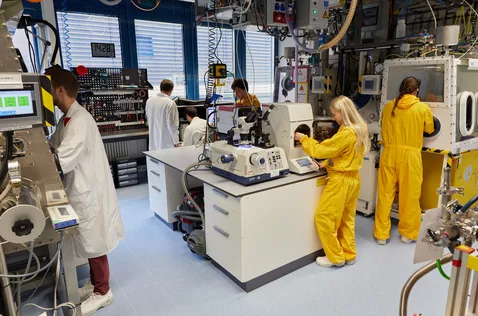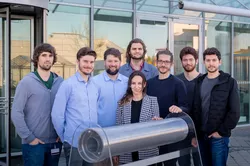Who is working on the conversion?

A working group of around twenty people has been conducting research at the FRM II since 2003 on the development, production, and qualification of such fuels and the development of suitable reactor core designs for the conversion of the FRM II. This happened in international cooperation, including France, Belgium, and the USA.
To this end, the working group uses only the latest and best experimental and computer-aided methods, such as material characterization using high-resolution scanning electron microscopy with electron backscattering diffraction or three-dimensional simulation of the thermal-hydraulic conditions in the reactor core using numerical fluid mechanics.
Project team at the FRM II
Following the decision in favour of the monolithic uranium-molybdenum (UMo) fuel, it is now a matter of putting the theoretically established convertibility, confirmed by independent teams of experts, into practice.
To this end, a cross-departmental project team at the FRM II will further optimize the fuel element design over the next few years and prepare to initiate the approval procedure and the fabrication of new fuel elements. Accompanying the technical and nuclear implementation, the necessary scientific work will continue to be carried out at the TUM Centre for Nuclear Safety and Innovation (TUM CNIS).
The production of UMo foils and fuel plates is being prepared at the French company Framatome.
Scientific findings and funding
Numerous scientific publications document the progress made by the working group (see MLZ publication archive).
The working group's research is funded by a joint grant from the Federal Ministry of Education and Research (BMBF) and the Bavarian State Ministry of Science and the Arts (StMWK), as well as four EURATOM-funded projects to date (HERACLES-CP, LEU-FOREvER, EU-QUALIFY and, from autumn 2024, EU-CONVERSION) as part of the EU Commission's HORIZON 2020 and HORIZON Europe programs.
International Collaborations
Together with international partners from research and industry, the working group is also actively involved in international fuel research and the further development and validation of computer codes, and regularly presents its progress at conferences and in scientific publications.
Exemplary for the international cooperation is the HERACLES consortium, an association of the European fuel developers and manufacturers Framatome-CERCA (France), CEA (France), ILL (France), SCK CEN (Belgium) and TUM. In addition, there are close collaborations with the U.S. national laboratories Argonne National Laboratory (ANL), Pacific-Northwest National Laboratory (PNNL), Idaho National Laboratory (INL), Los Alamos National Laboratory (LANL) and Oak Ridge National Laboratory (ORNL).
